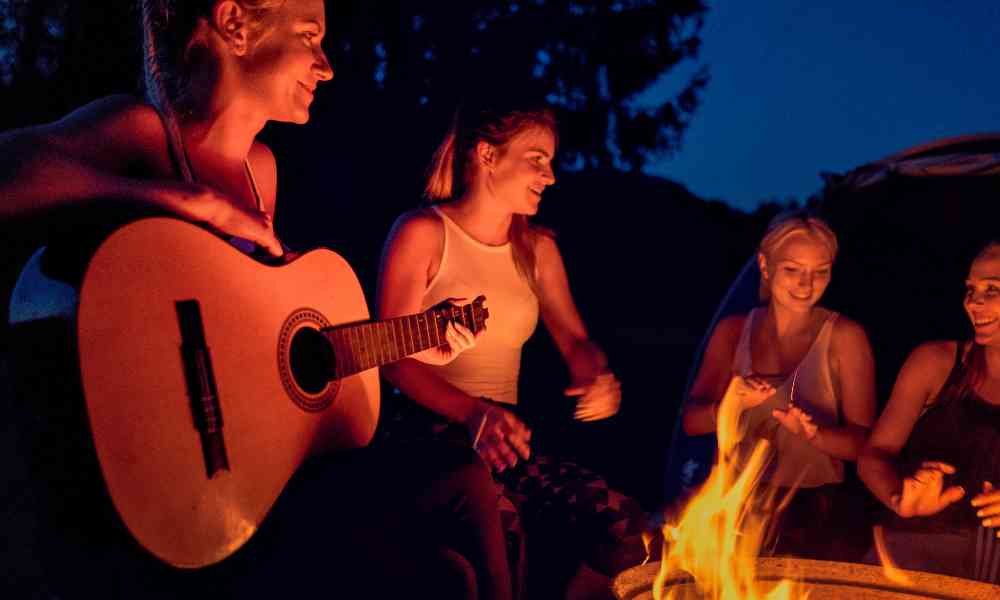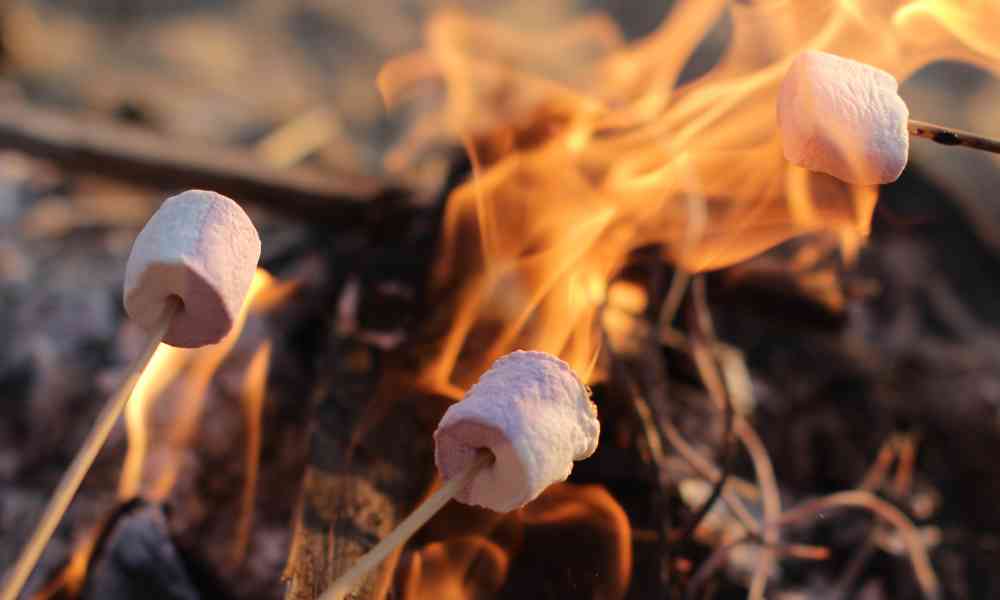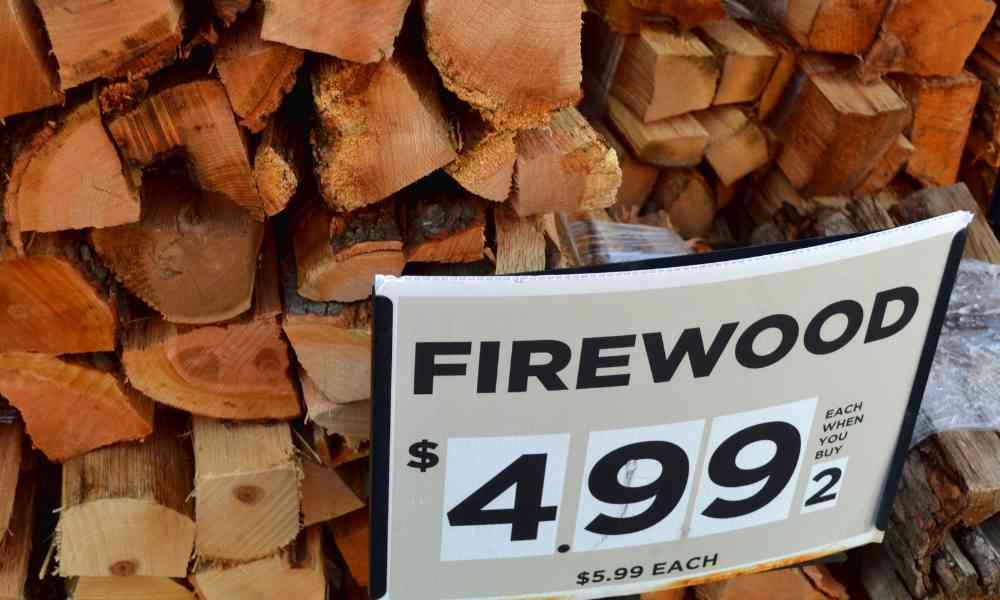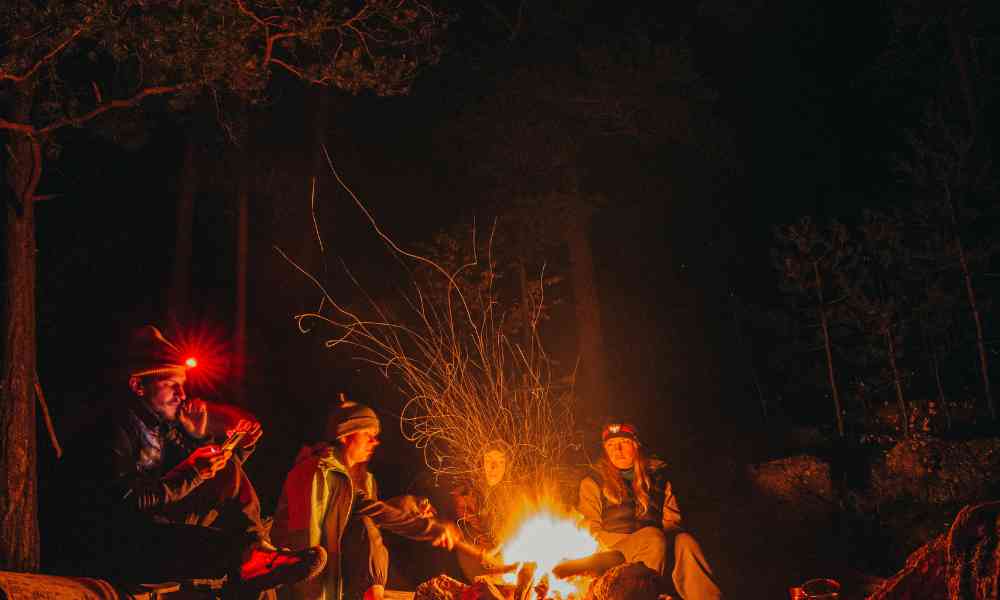One of the most beloved parts of camping is sitting around a fire, roasting some marshmallows for smores, and enjoying time with friends and family. However, many campers are often left wondering just how much firewood they need for the trip. Too often, campers are left with a lot of wood unused or, worse, not enough for the trip. After reading this article, you should have a good idea of just how much wood you need. We also provided a handy calculator to help with your planning needs. However, if you need a fast and simple answer, a safe bet is to pick up 1 bundle of firewood for every 2 hours of camping, assuming you plan to have a standard fire in a regular campground firepit.

Understanding Your Firewood Needs
Camping is a beloved outdoor activity that reconnects us with nature and provides a break from the hustle and bustle of daily life. An essential part of this rustic experience is the campfire. It’s not just a source of warmth; it’s a centerpiece for storytelling, cooking, and creating memories. However, one crucial question often perplexes campers: “How much firewood do I need?” We’ll delve into the factors that influence your firewood needs.
Below is a simple calculator to help you plan for your firewood needs. The calculator assumes you are using seasoned hardwood firewood, which is what you will likely find for sale at a campground or convenience store in bundles of wood. If you camp in the same place all season, you may want to look to purchase it by the cord.
Firewood Calculator
Campfire Firewood Calculator
Duration of the Trip
The length of your camping trip is the primary factor in determining your firewood needs. It goes without saying that a weekend getaway will require significantly less wood than a week-long expedition. A practical approach is to estimate your daily firewood usage and then multiply it by the number of days you plan to camp. Consider the standard measure of a cord of wood or a face cord, and think about purchasing enough wood, with a little extra, to ensure you have enough. It’s better to have a bit of extra firewood than not enough, especially if you’re camping in remote areas where resupplying isn’t an option.
Number of Campers
The number of people on the trip influences how much firewood you’ll need. More campers typically mean larger fires to accommodate cooking for more people and provide sufficient warmth for the group. This doesn’t mean the amount of firewood needed increases linearly with the number of campers, but it’s a crucial factor to consider.

Intended Use of Fire
Your firewood requirements also depend heavily on the intended use of the fire. Here are three primary uses:
- Cooking: If you plan to do most of your cooking over the fire, you’ll need a steady, controlled flame, which often requires more wood. Cooking meals over an open fire also tends to take longer than using a camping stove, adding to the wood consumption. You might need several firewood bundles for this purpose.
- Warmth: In colder climates or during winter camping, a fire for warmth is a must. These fires typically burn longer and stronger throughout the night, increasing your firewood needs. You’ll use more bundles of firewood on a cold night if you’re trying to stay warm.
- Ambiance: Many campers enjoy a fire for its ambiance. These fires don’t necessarily need to be large or long-burning, but they are usually a nightly occurrence, so plan accordingly. Free or cheap firewood might suffice for ambiance fires.
The Importance of Planning
Proper planning is vital to ensure you have enough firewood for your trip. Underestimating your needs can lead to uncomfortable, even dangerous situations, especially in cold weather. Overestimating, while less risky, can lead to waste and unnecessary effort in transporting extra wood. Consider creating a firewood checklist tailored to your specific camping plans, accounting for the trip duration, the number of campers, and your fire’s intended use.
By understanding these key factors and planning accordingly, you can ensure that your camping experience is safe, enjoyable, and well-equipped. Remember, a campfire is more than just a source of heat or a means to cook food; it’s a part of the camping experience that should be carefully and responsibly managed.

Selecting the right type of firewood
When you’re planning a camping trip, selecting the right type of firewood is as important as determining the quantity you’ll need. Firewood can broadly be classified into two categories: hardwoods and softwoods. Each type has distinct burning properties that can significantly impact your camping experience. Let’s explore these differences and recommend the best types of firewood for your next camping adventure.
Hardwoods
Hardwoods come from deciduous trees, which lose their leaves annually. Examples include oak, ash, birch, and maple. If you want your campfire to burn for a long time, the best wood is hardwood. Here are their key characteristics:
- Longer Burning Time: Hardwoods are denser and have a lower sap and resin content, which means they burn slower and longer. This makes them ideal for campfires that need to last through the night or for extended cooking sessions.
- More Heat: Due to their density, hardwoods produce more heat. This is especially beneficial in colder conditions.
- Less Smoke and Sparking: Hardwoods tend to produce less smoke and fewer sparks compared to softwoods, making them safer and more comfortable to use.
Best Hardwoods for Camping
- Oak: Known for its long burn time and steady heat.
- Maple: Offers a good balance of burn time and heat output.
- Birch: Easy to ignite, with a moderate burn time.
Softwoods
Softwoods come from coniferous trees, which typically have needles and cones. Common examples are pine, cedar, and spruce. Their characteristics include:
- Faster Burning: Softwoods burn more quickly because they are less dense and have higher sap and resin content.
- Easier to Ignite: The higher resin content makes softwoods easier to ignite, which can be handy for starting fires.
- More Smoke and Sparks: They tend to produce more smoke and sparks, which can be a drawback, especially in dry conditions.
Best Softwoods for Camping
- Pine: Excellent for kindling and getting a fire started.
- Cedar: Known for its pleasant aroma and good for quick, warm fires.
- Spruce: Easy to split and good for kindling.
Recommended wood for Camping
For most camping situations, the best firewood is hardwoods for their superior qualities. Their long burn time, higher heat output, and lower smoke production make them ideal for both cooking and warmth. However, softwoods shouldn’t be discounted; they’re great for kindling and getting your fire started. A mix of both hardwood for the long burn and softwood for easy ignition can often be the best approach.
Remember, the availability of specific types of wood will vary depending on your location. It’s also crucial to source your firewood responsibly to prevent the spread of pests and diseases. Whenever possible, purchase wood near your camping site or from a reputable dealer.
Wood Shape and Size
When considering the style of firewood on campfire burn time, it’s essential to understand the characteristics of different shapes like slat wood, split wood, and square wood. Here’s an overview of each type and how they influence the burn time:
Slat Wood:
- Description: Slat wood typically refers to thin, long pieces of wood, often resembling slats used in construction or furniture making.
- Burn Characteristics: Due to their thin and elongated shape, slat wood tends to catch fire quickly and burns fast. This rapid burning can be useful for starting fires but may require frequent replenishment to maintain a campfire.
- Impact on Burn Time: Generally results in a shorter burn time due to the quick consumption of the material.
Split Wood:
- Description: Split wood is what most people traditionally think of as firewood. It’s created by splitting logs into halves or quarters, usually with a wedge-like shape.
- Burn Characteristics: This shape allows for more surface area exposure, enhancing the fire’s ability to consume the wood. Split wood burns more efficiently and steadily than slat wood.
- Impact on Burn Time: Offers a moderate burn time, balancing quick ignition with a more sustained burn compared to slat wood.
Square Wood:
- Description: Square wood refers to wood cut into square or rectangular blocks. This shape is less common in casual campfire settings but can be found in certain types of wood fuel supply.
- Burn Characteristics: The compact and dense nature of square wood means it takes longer to catch fire, but once ignited, it burns slowly and consistently.
- Impact on Burn Time: Provides a longer burn time due to the density and reduced surface area exposed to flames compared to split wood.
In summary, the shape of the firewood significantly affects the campfire’s burn time. Slat wood burns quickly but for a short duration, split wood offers a balance between quick ignition and sustained burn, and square wood, though slower to start, burns for a longer period. Choosing the right type of wood depends on the specific needs of the campfire, such as whether the goal is a quick, bright fire or a long-lasting, steady heat source.
The Importance of Seasoned Firewood for Campfires
When planning a campfire, the choice of firewood can greatly influence the overall experience. One key factor often overlooked is whether the wood is seasoned or unseasoned (also known as green wood). Seasoned firewood is wood that has been allowed to dry over a period of time, usually at least six months to a year. This process significantly impacts the wood’s burning properties and can make a considerable difference in your campfire’s efficiency and environmental impact. Wet wood doesn’t burn well and will make starting and maintaining a fire challenging.

Benefits of Using Seasoned Firewood
1. Easier Ignition
- Seasoned wood has a lower moisture content compared to unseasoned wood. This dryness allows it to catch fire more easily and quickly, reducing the time and effort required to start your campfire.
2. More Efficient Burning
- Dry wood burns more efficiently than green wood. It produces more heat and burns more completely, meaning you’ll get more energy out of each log. This efficiency is crucial when relying on the fire for warmth or cooking.
3. Less Smoke and Creosote
- Burning seasoned wood significantly reduces the amount of smoke and creosote (a tar-like substance) produced. Less smoke means a more pleasant experience around the campfire, and less creosote buildup reduces the risk of chimney fires if you’re using a wood stove or fireplace at a campsite.
4. Environmental Considerations
- Efficient burning also translates to environmental benefits. Seasoned wood produces fewer pollutants and particulates compared to green wood. This means a cleaner, more environmentally friendly campfire.
Identifying Seasoned Firewood
Recognizing seasoned firewood is relatively straightforward. Look for wood that:
- Has darkened, cracked ends.
- Sounds hollow when knocked against another piece of wood.
- Feels lighter due to reduced moisture content.
- Has bark that peels off easily.
- A moisture meter can be helpful to ensure the wood burns efficiently.
Tips for Seasoning Your Firewood
If you have access to a wood supply and plan to season it yourself:
- Cut and split the wood to the right size for your fire pit or stove.
- Store it off the ground in a dry, sunny spot.
- Cover the top to protect from rain but allow air to circulate.
Purchasing wood at a campground or convenience store
When buying firewood by the bundle when camping, chances are you’ll be getting it from the camp store or a local gas station. If it’s packaged, it should state what type of wood it is. If it doesn’t, you can always ask, but they may not always know. Below are the common types of bundled firewood for sale, with hardwoods being the most popular.

- Local Hardwoods: Many campgrounds and stores, especially in regions with abundant forests, sell local hardwoods. Examples include oak, maple, ash, and birch. These woods are popular due to their high heat output and longer burning time. Hardwoods are preferred for campfires because they create less smoke and spark less than softwoods.
- Pine and Other Softwoods: In some areas, especially those with fewer hardwood forests, pine and other softwoods may be more commonly available. These woods ignite more easily than hardwoods, making them good for starting fires. However, they burn faster and produce more smoke and sap, which can lead to a buildup of creosote.
- Packaged Firewood: At many gas stations and some campgrounds, you’ll find packaged firewood. This firewood is often a mix of various types of woods, sometimes including both hardwoods and softwoods. It’s usually kiln-dried, which means it has a lower moisture content and is less likely to harbor insects or diseases. The downside is that it can be more expensive than buying firewood in bulk.
Campfire Management: Ensuring Safety and Efficiency
When it comes to enjoying a campfire, effective management is key to safety, efficiency, and environmental responsibility. Whether you’re aiming for a small campfire for ambiance or a roaring fire for warmth and cooking, understanding how to control and maintain your fire is crucial. Here are some considerations for managing different types of campfires:
Size of the Fire
- Small Fire/Small Campfire: Ideal for limited spaces or when a minimal fire is required, such as for ambiance or light cooking. Smaller pieces of wood are perfect for this type of fire, as they catch easily and burn steadily without creating a large flame.
- Larger Fire/Roaring Fire: Suitable for a larger group, especially in colder weather or for more extensive campfire cooking. Larger logs are needed to sustain a larger fire, and they burn for a longer time. However, larger fires require careful monitoring to ensure they remain controlled.
Duration and Intensity
- Long Time/Longer Time: If you need the fire to last for an extended period, such as for an all-night campfire, it’s important to maintain a steady burn. This can be achieved by regularly adding wood to the fire, balancing between smaller pieces for quick combustion and larger logs for sustained burning.
- Average Campfire Burns: The typical campfire burns for a few hours, which is sufficient for an evening of storytelling, marshmallow roasting, or warmth. Regularly adjusting the wood and controlling the size of the fire helps maintain an ideal burn.
Campfire Uses
- Open Flame/Steady Burn: For cooking, a steady burn is essential. This usually requires an open flame that’s consistent and hot enough to cook food efficiently. Fire management in this case often involves adding wood at regular intervals and using fire pits or fire rings to contain the fire safely.
- Campfire Cooking: For those who enjoy cooking over an open flame, whether it’s grilling or using a Dutch oven, managing the heat is critical. The fire should be hot enough to cook the food but not so intense that it burns.
Campfire Safety
- Fire Pits/Fire Ring: These are essential for containing the fire and preventing the spread of flames. Whether you’re building a small or large fire, always use a designated fire pit or fire ring if available. This not only confines the fire but also minimizes its impact on the surrounding environment. Learn more about wood-burning safety here.

Environmental Considerations and Regulations
Buying and transporting firewood involves several important environmental considerations. These considerations are crucial for preserving local ecosystems and preventing the spread of invasive species and diseases, especially in sensitive areas like state parks and national parks. Here are the key points to keep in mind:
Risk of Spreading Invasive Species and Diseases
- Firewood can harbor harmful pests and diseases, such as the emerald ash borer or Asian longhorn beetle. When transported over long distances, these pests can be introduced to new areas, potentially devastating local forests and ecosystems, including those in state parks and national parks.
Buying Locally
- One of the most significant actions you can take to mitigate these risks is to buy firewood locally. Purchasing firewood near your camping site or from within the same region helps prevent the transport of non-native pests and diseases. This practice is particularly crucial in areas with burn bans or fire bans due to weather conditions.
- Many parks and campgrounds, especially those in state parks and national parks, advise or require that firewood be sourced locally, often within a specific radius (like 50 miles), to comply
Heat-Treated Firewood
- If you need to transport firewood, look for options that are certified as heat-treated. This process involves heating the wood to a temperature that kills any hidden pests and diseases, resulting in wood that produces little smoke when burned.
- Heat-treated firewood is often marked with a seal or label indicating it has been treated and is safe to transport, aligning with local regulations and guidelines.
Awareness and Compliance with Regulations
- Be aware of and comply with state and federal regulations regarding the transport of firewood. Some regions, including state parks and national parks, have strict rules to protect their natural resources against invasive species and ensure minimal environmental impact, including regulations related to the production of smoke and adherence to fire bans.
- Check for any specific guidelines provided by the campground or park you plan to visit, as local regulations can vary significantly.
Final Thoughts
In conclusion, preparing for a campfire is more than just a practical task; it’s an integral part of the camping experience that blends tradition with environmental responsibility. This article has guided you through the essential considerations for estimating your firewood needs, from the duration of your trip and the number of campers to the intended use of the fire. Remember, our handy calculator is a great resource for planning, but as a quick rule of thumb, allocating one bundle of wood for every two hours of fire should generally meet your needs.
We’ve also explored the significance of choosing the right type of firewood, highlighting the advantages of dense hardwoods for longer, warmer fires and softwoods for easy ignition. Seasoned firewood emerged as a superior choice for its efficient burning and environmental friendliness. When purchasing firewood, especially at campgrounds or convenience stores, opting for local hardwoods can enhance your campfire experience while protecting local ecosystems from invasive species and diseases.
Finally, the environmental considerations associated with buying and transporting firewood cannot be overstated. By choosing local or heat-treated wood and adhering to regulations, you play a crucial role in preserving our forests and their biodiversity. Each decision, from the type of wood to its source, reflects a commitment to sustainable camping practices. For instance, using your own firewood, sourced responsibly, can be a good option. And remember, while a full cord of wood might be excessive for casual campers, understanding its dimensions (128 cubic feet) helps in making a rough estimate for your needs.
In essence, a well-planned, responsibly sourced campfire goes beyond keeping you warm and cooking your meals; it’s about preserving the natural beauty that makes camping so special. So next time you gather around the campfire, let it not just be a source of light and warmth but also a testament to thoughtful planning and environmental stewardship. Whether you’re in a national park or a local camping area, the best choice is always the one that balances enjoyment with environmental care. Happy camping!
